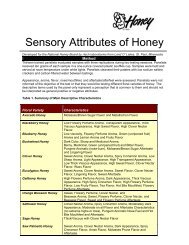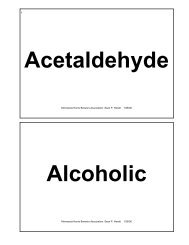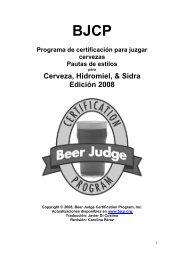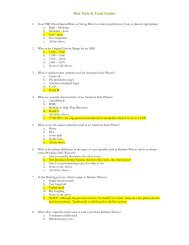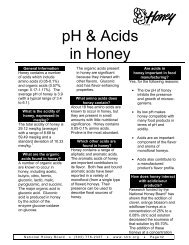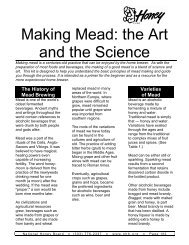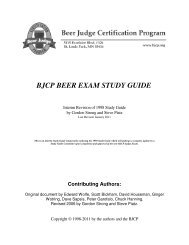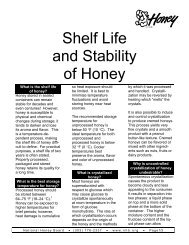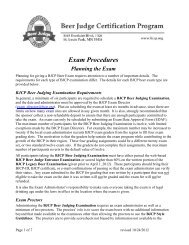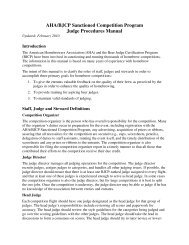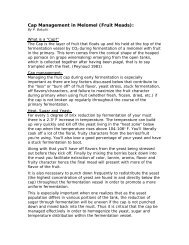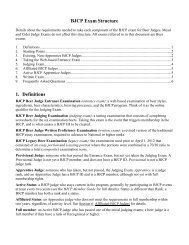Style Flashcards - BJCP
Style Flashcards - BJCP
Style Flashcards - BJCP
Create successful ePaper yourself
Turn your PDF publications into a flip-book with our unique Google optimized e-Paper software.
8A. Standard/Ordinary Bitter<br />
Category: 8. ENGLISH PALE ALE<br />
OG: 1.032 – 1.040 FG: 1.007 – 1.011 ABV: 3.2 – 3.8%<br />
IBU: 25 – 35 SRM: 4 – 14<br />
Commercial Examples: Boddington's Pub Draught, Fuller's Chiswick Bitter, Oakham Jeffrey Hudson Bitter (JHB),<br />
Young's Bitter, Brakspear Bitter, Adnams Bitter<br />
Aroma: The best examples have some malt aroma, often (but not always) with a caramel quality. Mild to moderate<br />
fruitiness is common. Hop aroma can range from moderate to none (UK varieties typically, although US varieties may<br />
be used). Generally no diacetyl, although very low levels are allowed.<br />
Appearance: Light yellow to light copper. Good to brilliant clarity. Low to moderate white to off-white head. May<br />
have very little head due to low carbonation.<br />
Flavor: Medium to high bitterness. Moderately low to moderately high fruity esters. Moderate to low hop flavor<br />
(earthy, resiny, and/or floral UK varieties typically, although US varieties may be used). Low to medium maltiness with<br />
a dry finish. Caramel flavors common but not required. Balance often decidedly bitter, although the bitterness should<br />
not completely overpower the malt flavor, esters and hop flavor. Usually no diacetyl, although very low levels allowed.<br />
Mouthfeel: Light to medium-light body. Carbonation low, yet bottled and canned examples can have mod. carb.<br />
Overall Impression: Low gravity, low alcohol levels and low carbonation make this an easy-drinking beer. Some<br />
can be more malt balanced, but this should not override the overall bitter impression. Drinkability is a critical<br />
component of the style; emphasis is still on the bittering hop addition as opposed to the aggressive middle and late<br />
hopping seen in American ales.<br />
Ingredients:<br />
• Water: Often medium sulfate water is used.<br />
• Malt: Pale ale, amber, and/or crystal malts, may use a touch of black malt for color adjustment.<br />
• Hops: English hops typical, although American and European varieties are becoming more common in the<br />
paler examples.<br />
• Yeast: Characterful English yeast<br />
• Other: May use sugar adjuncts, corn or wheat.<br />
Copyright © 2004, <strong>BJCP</strong>, Inc. All rights reserved.<br />
•<br />
8B. Special/Best/Premium Bitter<br />
Category: 8. ENGLISH PALE ALE<br />
OG: 1.040 – 1.048 FG: 1.008 – 1.012 ABV: 3.8 – 4.6%<br />
IBU: 25 – 40 SRM: 5 – 16<br />
Commercial Examples: Fuller's London Pride, Coniston Bluebird Bitter, Timothy Taylor Landlord, Robinson’s<br />
Northern Glory, Shepherd Neame Masterbrew Bitter, Greene King Ruddles County Bitter, RCH Pitchfork Rebellious<br />
Bitter, Brains SA, Harviestoun Bitter and Twisted, Goose Island Honkers Ale, Rogue Younger’s Special Bitter<br />
Aroma: The best examples have some malt aroma, often (not always) with a caramel quality. Mild to moderate<br />
fruitiness. Hop aroma ranges from moderate to none (UK varieties typically, US varieties may be used). Generally no<br />
diacetyl, very low levels are allowed.<br />
Appearance: Medium gold to medium copper. Good to brilliant clarity. Low to moderate white to off-white head.<br />
May have very little head due to low carbonation.<br />
Flavor: Medium to high bitterness. Moderately low to moderately high fruity esters. Moderate to low hop flavor<br />
(earthy, resiny, and/or floral UK varieties typically, although US varieties may be used). Low to medium maltiness with<br />
a dry finish. Caramel flavors common but not required. Balance often decidedly bitter, yet the bitterness should not<br />
completely overpower the malt flavor, esters and hop flavor. Generally no diacetyl, yet very low levels are allowed.<br />
Mouthfeel: Medium-light to medium body. Carbonation low. Bottled and canned commercial examples can have<br />
moderate carbonation.<br />
Overall Impression: Flavorful, yet refreshing, session beer. Some can be more malt balanced, but this should not<br />
override the overall bitter impression. Drinkability is a critical component of the style; emphasis is still on the bittering<br />
hop addition as opposed to the aggressive middle and late hopping seen in American ales.<br />
Ingredients:<br />
• Water: Often medium sulfate water is used.<br />
• Malt: Pale ale, amber, and/or crystal malts, may use a touch of black malt for color adjustment.<br />
• Hops: English hops most typical. American and European varieties are becoming more common<br />
• Yeast: Characterful English yeast.<br />
• Other: May use sugar adjuncts, corn or wheat.<br />
Copyright © 2004, <strong>BJCP</strong>, Inc. All rights reserved.<br />
•



